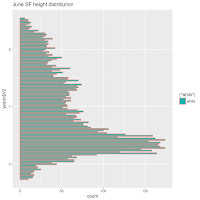David Pugh, in
Sea Level Science introduces probability distribution diagrams as an analytical tool. The beeswarm plots from a couple of posts ago are another way of representing distributions along one axis. The idea is to plot a span of data (or in my case, usually predictions) along a single axis.
What does a probability distribution tell us? It can give us an idea how many hours per day an organism in a particular zone will be exposed to the air. It would be more interesting to know the tides of exposure to sunlight. For corals this is essential. David Pugh says that the S2 harmonic constituent can give us an idea without graphs. This is a subject for a future project.
For how, the following is an effort from several months back, breaking down the probability distributions of heights month by month, for San Francisco's venerable tide gauge (thought these may be predictions). I wonder what this has to say in comparison with St. Petersburg, Florida's beeswarm plot. Obviously, it's impossible to compare them well using these two distinctly different methods. The top row shows frequency distributions for January, February, and March, and so on in the other rows; all graphs are from predictions.
One thing I noticed was a similarity of the distributions for June and December, around times of Solstices. The same may be said for the months of the Equinoxes, March and September. I now want to see another graph, the specific one-day distributions for the exact days of Solstices and Equinoxes. Other parameters, like apogee and perigee, perihelion and aphelion, lunar declination have important effects.
Comparing Two Sites (Full year of predictions for each)
San Simeon is on the exposed California Coast.
Port Chicago some 30 miles up the Northern Reach of San Francisco Bay, in Suisun Bay.
Months of Solstices and Equinoxes,
Chuuk Lagoon
 |
| December |
 |
| March |
 |
| June |
 |
| September |
Equinoxes are in March and September. Solstices are in December and September. Why do the Equinoxes resember one another? Why do the Solstices resemble one another? ???
Elkhorn Slough December, March, June, and September
The differences between Elkhorn Slough and Chuuk Lagoon are notable.
 |
| March |
 |
| December |
 |
| June |
 |
| September |
Another distribution diagram: a continuous distribution curve.
This time, each month is traced in a different color. This is experimental; I did not keep a record of the colors for each month!
And another way to represent similar data, with transparent fill:














No comments:
Post a Comment